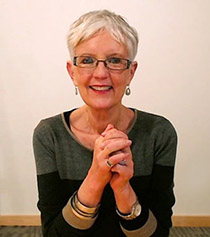How to Work with the Limbic System to Reverse the Physiological Imprint of Trauma
 |
with Pat Ogden, PhD ;
|
 |
with Pat Ogden, PhD; Peter Levine, PhD; Bessel van der Kolk, MD; Ruth Lanius, MD, PhD; and Ruth Buczynski, PhD
Sign up for a Gold Subscription

This is a learning community for practitioners. We can’t wait to hear what you’re going to use with your clients
But please do NOT:
- seek advice for personal problems
- ask for referrals
- post links or advertise a product
- post about technical problems
This workshop affirms the power of resonance with the horses in coaching clients in EAS. I feel a tightness in my body when a client only talks about their trauma rather than moving to take some physical action of connection and emotion. Once a person takes physical action to connect with horses or donkeys, there is a definite shift from the thinking to the feeling brain. I am a bottom-up kind of educator/coach. It goes deeper to combine processing with physical actions, but I could never just do talking alone.
I know someone who vaguely remembers being adversely affected by her mother’s hostile memory of difficulties before she was born and this has affected her self-worth even though she is highly accomplished. Today’s session is helpful in getting her to identify the body sensations connected with an image of her mother and to work in re-framing that image to connect new interpretations and sensations for her, allowing her to shift the negative perceptions of herself away from being unworthy.
Believe have this training from before but things have changed with clients. Want to work on the brain from the lower brain up with some clients. Now due to our major east to west coast browser and phone attack/problems we have here, my systems were damaged. Need to know how to access if this training was purchased and which system it is on in three of my damaged computers Believe have this training from before but things have changed with clients. Want to work on the brain from the lower brain up with some clients. Now due to our major east to west coast browser and phone attack/problems my systems were damaged. Need to know how to access if this training was purchased and which system it is on in three of my damaged in which three of my computers have been compromised. This has created, in itself, a trauma response in my research.
Also due to my personal memory that thas been compromised in past few years in our area due to personal trauma created by our land being compromised and problems in society I need to access those trainings. I work with clients whose trauma was stronger in a more cyclical manner.
Thanks to your speakers I have been able to stay abreast of the ramifications during this pandemid the entire time but it seems to be starting to excalate recently in compromise systems that house my videos and trainings since global wars and the pandemic. Many are awakening but to some different responses including the isolated area of my state. Thanks for the workshop. Let me know if I already have it, where I can track it down in four compromised systems in four systems to research. The IT has caused tremendous trauma for my aging brain that is slowly despite my precautions to remain in my three areas of the brain that knows brain trauma due to ongoing fears in society and in my own neighborhood in violence and vandalisms.
Also due to my personal memory that thas been compromised in past few years in our area due to personal trauma created by our land being compromised and problems in society I need to access those trainings. I work with clients whose trauma was stronger in a more cyclical manner. Thanks to your speakers I have been able to stay abreast of the ramifications during this pandemid the entire time but it seems to be starting to excalate recently in compromise systems that house my videos and trainings since global wars and the pandemic. Many are awakening but to some different responses including the isolated area of my state. Thanks for the workshop. Let me know if I already have it, where I can track it down in four compromised systems in four systems to research. The IT has caused tremendous trauma for my aging brain that is slowly despite my precautions to remain in my three areas of the brain that knows brain trauma due to ongoing fears in society and in my own neighborhood in violence and vandalisms. I specially appreciate Ruth Lannius input and have been looking for a book that was spoken of a few years ago?
Believe have this training from before but things have changed with clients. Want to work on the brain from the lower brain up with some clients. Now due to our major east to west coast browser and phone attack/problems we have here, my systems were damaged. Need to know how to access if this training was purchased and which system it is on in three of my damaged in which three of my computers have been compromised. This has created, in itself, a trauma response in my research.
Also due to my personal memory that thas been compromised in past few years in our area due to personal trauma created by our land being compromised and problems in society I need to access those trainings. I work with clients whose trauma was stronger in a more cyclical manner. Thanks to your speakers I have been able to stay abreast of the ramifications during this pandemid the entire time but it seems to be starting to excalate recently in compromise systems that house my videos and trainings since global wars and the pandemic. Many are awakening but to some different responses including the isolated area of my state. Thanks for the workshop. Let me know if I already have it, where I can track it down in four compromised systems in four systems to research. The IT has caused tremendous trauma for my aging brain that is slowly despite my precautions to remain in my three areas of the brain that knows brain trauma due to ongoing fears in society and in my own neighborhood in violence and vandalisms. I specially appreciate Ruth Lannius input and have been looking for a book that was spoken of a few years ago?
The two things i learned from this session and will watch in myself and others are these:
Bessel said that the “midline of the body is where trauma lives”…recalling that which is heart-wrenching and gut-wrenching.
Such a good clue to what has happened! And Joan said than mutual body scanning with a partner is a right-left
brain integrator. I never thought of it this way! As always thank you!
Thank you for this awareness of somatic psychotherapy! Very useful and intuitive.
I agree that it’s so important to steer folks away from that old fashioned idea of hitting a pillow when angry or to respond to their trauma. When we hit a pillow, we’re not being mindful, we’re rehearsing aggression and violence. When it’s all over, after pounding a pillow, the person is left with nothing – like she said, their thinking brain wasn’t integrated in the action, so nothing changed. They’re left feeling as impotent and ineffectual as when the trauma happened and they couldn’t do anything about it. Treatments and movements that integrate the whole brain are far more effective for the client.
Thank you so much. I am looking with different eyes at it after having faced a severe health crisis myself and had to work my own way out of (transgenerational) trauma.
Now, I will be able to share the wisdom you are giving away here from my own experience which makes a huge difference as it looks to me.
And as you say: y o u r work makes a real difference in the world, thank you so much again for this. 🧡💙🙏
thank you all very muth for shering your work and kwnowledge with us. for me this is presiouse!!!
I will listen to the story, while making a shift to enquire about bodily sensations = the Somatic Narrative.
Profound!!! I am strongly contemplating on specialising in Trauma. I am a Clinical Psychologist (MA) but most of the learning here in Kenya is theory based. Are there opportunities for fellowships in the USA for Trauma Therapy specialists. I would love to work with Dr. Van der Kolk. It will be such an honour.
Once again Thank you for organising this program. It’s been mind opening. And as Dr. Ruth always states, when we help one recover from trauma ,we change the course of time.
I wanted to express a sincerest thanks to NICABM for sharing these tips and techniques for helping our clients cope with their trauma. I’m looking forward to introducing many of these strategies in my sessions.
I am not clear about what step preceded the “hands up and saying no”
by the jewellery salesperson when she was reorganizing the
experience of helplessness during the robbery ?
What did the psychiatrist tell her to do to start remembering the face of the robber and healing from the trauma ?
Thank you very much for this great opportunity to learn! I am a coach, live in Venezuela. Icould not pay, so I am very grateful for this free Series.
Many thanks for a most interesting and helpful series of webinars.
Hello Ruth, I truly love the work that you do!
I’m not a therapist by profession; I’m an artist.
My doctoral research is investigating ways in which creative activity can help build healthy family connections.
Thanks for the free offering 🙂
Regards,
Shabnam
Opening up speaking about a negative secret and tabu has ben part of my path towards recovery. The other person can be the mirror telling me that molestation and abuse is not a normal an ok to bring up a child. And talking can help me to accept my past in spite of denying.
But for real changes to happen I always needed my thinking brain, my emotional brain and survival brain to be “aligned.”
For me it was a very useful session. Thank you so much!
One of the most transformative learning experiences for me in 60 years as clinical psychology practitioner, now retired but now inspired to go back to work but in this way. And I will spread the word with colleagues who missed this series. I wish I could afford the gold subscription right now but will have to wait! Thanks for this great inspiration
Peter Trower
Thank you Dr. Ruth, and all. As I listen, I take notes & ideas that resonate with me. I often “star” especially relevant points. Normally I “star” about a half dozen during a presentation. Today was off the charts! At least 15 different “stars” or important ideas, that I will take forth to aid in discovery and healing. Thank you for your great offerings and professional wisdom.
These programs have been very healing over the years – I’ve had lots of therapy but the lack of focus on bodily symptoms was always lacking – I’d bring up how nervous I was, panic attacks, etc. – but the emphasis seemed to be on “left-braining” problems, which also created shame, unfortunately. So this is amazingly helpful, even in retrospect – in a “the truth shall set you free” kind of way. Maybe when you have integrated mind and body and know your story – it’s so great to understand how/why a symptom developed – then you can tell it. Having a story to tell vs. over-analyzing. Great stuff – I mention NICABM to anyone I think might relate to it and have bought several programs before. Thank you!
yoga was mentioned. For clients who are of a belief system that would not permit them to use yoga, an alternative is mentioned here: Praise Moves by Lynette Wills. She is a former yoga instructor who developed her own method that does not have the Eastern religious beliefs..
Yoga in actuality doesn’t have “ religious” belief content- however that’s irrelevant to someone who has the idea that it does! So this would be a good alternative. I do object to the continuation of the idea that yoga is based in a religion. It is not. It is wrong to propagate that false concept. .
Thanks to Dr. Ruth and the NICABM-Team and thanks to all the gold subscribers who make it possible for the others to watch for free! I am very grateful to get such important an helpful information! I am not a practitioner but a patient in Germany, who is suffering from complex PTSD and many other diagnosises like CFS. I haven`t had a “normal” life for decades now and I am not getting much help here in Germany. Even at the Institute of Psychotraumatology at the University of Cologne, I was told that they could not help me and didn`t know anybody who could help me with my complex case. After watching the series now I have hope, that I can help myself – at least a little bit – with the information, for example I will start with mindfulness, Yoga, Breathwork etc. But the most important fact for me is to know, that I am not crazy, but my brain is different from other brains because of trauma.
God bless you all!
Hello Claudia,
I know of a German therapist based in the US who may be able to provide support, depending on your situation. If it interests you, you can write me at riveracucu@gmail.com.
Yes, you will be able to help yourself. Speaking from my own experience which finally brought me to work in the field of Psychotherapy myself.
What has been very valuable to me, was being able to take in the information in the English language and the sort of “step by step” presenting it to the “German speaking” part of my brain, as I grew up with that language and most acquired trauma of mine seems to be related to that language (a mixture of explicit + implicit memory I guess). As it looks to me today, here in Germany many of us share a specific type of transgenerational trauma, which is so far not addressed by traditional therapy methods.
And so, following NICABM’s / Ruth’s work over years has been tremendously helpful and valuable to me. I also very much like the “Psychotherapy Infographics”, as they are addressing both hemispheres. And I found it helpful to translate some of them into German for myself to present their content through all of my senses to my German speaking parts.
As you mentioned CFS, it might be helpful for directly addressing that to look for the work of Alex Howard, a British Therapist, who is explicitly offering free seminars + also trainings into “Therapeutical Coaching” on this topic as he is able to speak from his own experience there. His main book on the topic has also already been published in German, you will find it i.e. on Amazon. I hope, this will not be classified as “advertising a product”.
Wishing you all the best and a good recovery. 🧡💙🙏
I am looking forward to applying the ideas to the work with my students and clients. As a psychologist and spiritual healer I usually work with a client on the conscious, intellectual and emotional levels and with spiritual energy transfer on the fundamental energy level, and as a Feng Shui Master I can enlarge their awareness of the influences in their environment, Now, with more of an understanding of how the experience of traumatic events affects the physical expression of the client, I’m sure it will enhance the way my clients and I communicate with each other. Although I have used NLP exercises and hypnotherapeutic techniques to restructure their world view perceptions, I can utilise the understandings and techniques leant here to fast-track their process of integration. I feel as if I’ve found an important missing piece of a complex jigsaw! I’m impressed with the quality of these five sessions and have bought the Gold Package. Thank you for a week of enriching study.
Excellent information, I have a private practice and work with many veterans cljents via referral from VA, so these are strategies I can use and/or combine with other resources. Thank you for this opportunity.
Once again, this course has been incredible, thank you! Excellent presentation and flow of learning material.